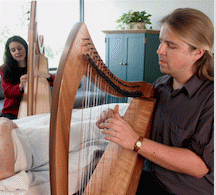JB: That meeting certainly was fortuitous! The harp figures prominently in music-thanatology. It's not a popular instrument like a violin or a piano or even a horn. What's so special about a harp?
TP: Well first, I should be clear, we are not talking about the big concert harps that you see in the symphony. These are much smaller "folk" harps. The idea is the same, but the scale is much more suited to playing at the bedside; mine's a little over four feet tall. Anyway, the harp gets a lot of attention, in part because it is a little unusual, but if we think about what I was describing earlier - the idea of weaving together those basic building blocks of music based on what's going on for a patient - we'll see that what is needed is a lot of versatility from the instrument. I need something that is portable, that gives me the option of singing while I play, and most importantly, is polyphonic - meaning it can play many notes at the same time. Horns have two strikes: can't sing while you play, and you only get one note at a time, so no chords or countermelodies or harmonies. A piano has everything you need except portability. You could go with an electronic keyboard, but then you lose a lot in terms of warmth and tone. Also, think about going into an intensive care unit with all the bells and whistles of modern medicine. Another machine is not going to have the same effect that a live, ringing, wooden instrument will. A violin can't do chords (mostly) or countermelodies.
Your options have been whittled down to guitar, harp, and accordion. The main issue with the accordion is the quality of the sound. It uses reeds and they produce the instrument's characteristic tone. You can identify it in an instant. What the harp gives is pure tone, almost without any characteristic flavor, or timbre. When I play two notes together on the harp, you don't even notice the harp; you just get pure harmony as those two notes ring together - a perfect musical building block. You could do this with a guitar, but it is much harder. Most guitarists play chords OR a melody, it's why rock bands typically have a rhythm guitarist and a lead guitarist. It takes a really masterful player to be able to do both simultaneously, but the harp is designed for just such a thing. So the real reasons for the harp are these very practical ones, but the harp also comes with other associations. It conveys a symbolic element for some people, a sculptural element for others.
Since we don't encounter harps everyday, we don't have preset ideas about how we are supposed to be around them. Walking in with a harp gives people permission to be a little more present, unencumbered by their habitual ways of doing things. This is really important in the context of dying, because people rarely know what to do. They are often lost, and hurting, and the harp is something entirely different. The harp, and the music, help carve out a space in which people are free to figure out how they are going to go about this process - and here I'm talking about the patients, as well as the families.
JB: What a thorough explanation. I heard something else about why a harp is used in hospice. It has to do with the sound waves it produces. I found that fascinating. Do you know what I'm referring to? And can you explain it a bit better, more fully, than I am?
TP: Sure. There are a couple of different things going on here. The first is what I mentioned about timbre, or the character of a musical tone. You can play the exact same note, or pitch on a bell or on a set of bagpipes, let's say, but the 'flavor' of the sound will be drastically different. If you make a graph of the sound wave, the bell will look like a perfect sine wave, while the bagpipes will look like a magnitude 9 earthquake on a seismograph. The first is pure tone, the second is pure character. The harp is pretty close to the bell, on that spectrum. Next, the strings of the harp are allowed to ring, unlike a guitar, for example, where the strumming makes for a lot of stopping and starting of the string's vibration - which can make the guitar quite lively. The harp strings, on the other hand, ring until they fade gently and at their own pace. We are so rushed and hurried in our lives, but the harp is not that at all. It is a reminder to stop and linger, and wait.
Then, on a more technical level, the extended ringing of the string allows for the emergence of the overtone series. This is a principle of the physics of acoustics that describes how one pure tone will engender others above it. The result is an expanded sense of space, like you get in a cathedral or concert hall - buildings that were designed to foster the production of overtones. A well-tuned harp will do that too. So for someone with emphysema, hungry for air and stuck in a cramped room in a nursing home, the harp can transform their sense of the space, making it feel easier to breathe. This concert hall-feel and the overtone series make us feel like we are somewhere other than our typical little rooms with our typical, truncated sounds. This can also formalize the setting, or differentiate it into one that is typically more suited for deeper meaning making.

Music-thanatologists Tony Pederson and Margaret Pasquesi perform a music vigil for a patient at Midwest CareCenter
(Image by Courtesy of Midwest CareCenter) Details DMCA
JB: Is it like the effect that I get from my Oriental singing bowl? I love to give it a good whack. The tone hums along for a long while afterward, gradually fading into nothingness. Very Zen. Before you started the music-thanatology program, were you a musician? It sounds like you have a lot of familiarity with various instruments. What do you play, besides the harp?
TP: That is exactly what the singing bowl is doing, and why it has the effect it has. And yes, I was a musician, but not everyone comes at it from that angle. I had sung in choirs all my life, and my mother had made me take piano lessons, which I hated, and that I am now very grateful for. But I had never seen a harp in person before those two walked into my dementia unit.
JB: I'd like to know more about the program in music-thanatology. Please fill us in. How long was it? Do you get a degree? Did they teach you to play the instruments too? Did you feel prepared immediately after graduation to go out and do the work you do now?
TP: It was a two-and-a-half year program that was a bit like music school coupled with first year med school - for anatomy and physiology, disease processes, and pharmacology in hospice and palliative care; "spiritual psychology" - to address the students' inner preparedness to do this work; and then a large component of liberal arts with a very specific focus on death and dying. At the time, the field was too new to be a degreed program, but certification is available through the Music-Thanatology Association International. I also went through an extensive internship as part of this education.
One of my first jobs out of school was in New Mexico, with a great non-profit called Circle of Love. On my first day, I got a call to go see a patient. On the way to the vigil, I got horribly lost, because Santa Fe is a very old city, and the streets are fairly convoluted. This was in the days before GPS and smartphones. I finally found the right part of the right street, and even then ended up knocking on the wrong door of the wrong house. Eventually I got to the right place, got the harp unpacked and tuned, then brought it into the patient's bedside. I was slightly frazzled until that precise moment, but then once I was with the patient, I was no longer lost - I knew just where to go and what to do. The training had done an incredible job of preparing me to be present to the dying, no matter the circumstance. Now it is twenty years later and I have seen an amazing variety of things at those bedsides, yet that training has always been valid, and this is probably because, as one of my teachers said, "it is really not a 'training program,' it is a formation process." You don't just learn a skill, you become the sort of person you need to be in order to be present in this way.
JB: I like that! So, does that mean that you're not contemplating any sudden career changes, then? Anything you'd like to add before we wrap this up?
TP: Ha! No, I've been with Midwest Palliative and Hospice CareCenter for the past 12 years. It's been a great fit, because as one of the premier hospice programs in the country, they are quite focused on setting the standard for excellent end-of-life care, and music has been a significant part of that effort. Not only do we have two music-thanatologists (shout-out to my colleague, Margaret Pasquesi, CM-Th) but we have a great team of music therapists, as well. Over the past several years, Margaret and I have been taking on interns from the existing music-thanatology schools, and that will hopefully culminate in our own Master's level training program in the Chicago area sometime in the future. On top of that, just last month our organization completed a merger with two other major non-profit hospice providers in the area; Horizon Hospice and JourneyCare, effectively tripling the patient census that we will be called upon to care for. As if that weren't enough, for the past year and a half I've been serving as the president of the Music-Thanatology Association International, so I have lots to do, and am pretty well and happily entrenched in this role.
(Note: You can view every article as one long page if you sign up as an Advocate Member, or higher).





